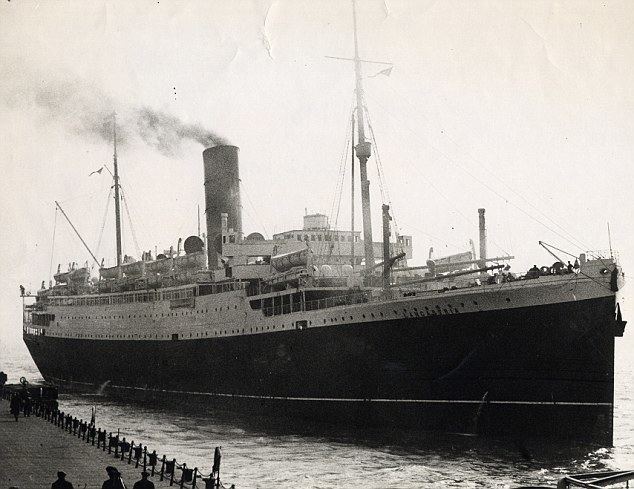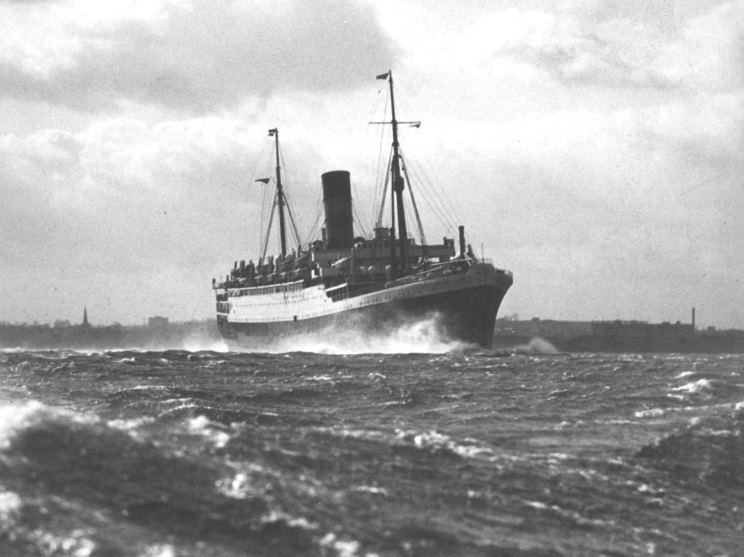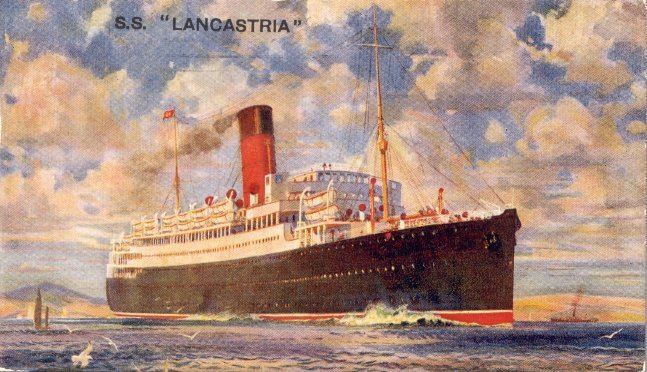Maiden voyage 19 June 1922 Length 168 m Draft 9.57 m Capacity 1,300 | Out of service 17 June 1940 Launched 1920 Beam 21 m | |
 | ||
Name RMS Tyrrhenia (1920–24)RMS Lancastria (1924–40)HMT Lancastria (1940) Nickname(s) as Tyrrhenia her crew called her"Old Soup Tureen" Fate sunk by air attack on 17 June 1940 Builder William Beard and Company | ||
The story of rms lancastria historic document
RMS Lancastria (later HMT Lancastria) was a British Cunard liner commandeered by the UK Government during World War II. She was sunk on 17 June 1940 during Operation Ariel. Having received an emergency order to evacuate British nationals and troops in excess of its capacity of 1,300 passengers, modern estimates range between 3,000 and 5,800 fatalities—the largest single-ship loss of life in British maritime history. The sinking of HMT Lancastria claimed more lives than the combined losses of the RMS Titanic (1,517 passengers and crew) and RMS Lusitania (1,198 passengers).
Contents
- The story of rms lancastria historic document
- Rms lancastria the ghost of st nazaire
- Career
- Sinking and its aftermath
- Availability of information
- Status of the wreck
- Remembrance
- The Lancastria Commemorative Medal
- Memorials
- References

Rms lancastria the ghost of st nazaire
Career

The ship was launched in 1920 as Tyrrhenia by William Beardmore and Company of Glasgow on the River Clyde for Anchor Line, a subsidiary of Cunard. She was the sister ship of RMS Cameronia that Beardmore's had built for the same customer the previous year. Tyrrhenia was 16,243 gross register tons, 578-foot (176 m) long and could carry 2,200 passengers in three classes. She made her maiden voyage, Glasgow–Quebec City–Montreal, on 19 June 1922.

In 1924 she was refitted for two classes and renamed Lancastria, after passengers complained that they could not properly pronounce Tyrrhenia. She sailed scheduled routes between Liverpool and New York until 1932, and was then used as a cruise ship in the Mediterranean and Northern Europe. On 10 October 1932 Lancastria rescued the crew of the Belgian cargo ship SS Scheldestad, which had been abandoned in a sinking condition in the Bay of Biscay. In 1934 the Catholic Boy Scouts of Ireland chartered Lancastria for a pilgrimage to Rome. With the outbreak of the Second World War she carried cargo, and was then requisitioned in April 1940 as a troopship, becoming HMT Lancastria. She was first used to assist in the evacuation of troops from Norway.
Sinking and its aftermath

The Lancastria was sunk off the French port of St. Nazaire while taking part in Operation Ariel, the evacuation of British nationals and troops from France, two weeks after the Dunkirk evacuation.

After a short overhaul, she left Liverpool on 14 June under Captain Rudolph Sharp (born 27 October 1885) and arrived in the mouth of the Loire estuary on 16 June. She anchored 11 miles (18 km) south-west of St. Nazaire. By the mid-afternoon of 17 June she had embarked an unknown number (estimates range from 4,000 up to 9,000) of civilian refugees (including embassy staff and employees of Fairey Aviation of Belgium), line-of-communication troops (including Pioneer and RASC soldiers) and RAF personnel. The ship's official capacity was 2,200 including the 375-man crew. Captain Sharp had been instructed by the Royal Navy to "load as many men as possible without regard to the limits set down under international law".

At 13:50, during an air-raid, the nearby Oronsay, a 20,000-ton Orient Liner, was hit on the bridge by a German bomb. Lancastria was free to depart and the captain of the British destroyer HMS Havelock advised her to do so, but without a destroyer escort as defence against possible submarine attack Sharp decided to wait.
A fresh air raid began before 16:00. Lancastria was bombed at 15:48 by Junkers Ju 88 aircraft from II. Gruppe/Kampfgeschwader 30. Three direct hits caused the ship to list first to starboard then to port; she rolled over and sank within twenty minutes. Over 1,400 tons of fuel oil leaked into the sea and was set partially on fire. Many drowned, were choked by the oil, or were shot by strafing German aircraft. Survivors were taken aboard other evacuation vessels, the trawler Cambridgeshire rescuing 900. There were 2,447 survivors, of whom about 100 were still alive in 2011. Many families of the dead knew only that they died with the British Expeditionary Force (BEF); the death toll accounted for roughly a third of the total losses of the BEF in France. She sank around 5 nmi (9.3 km) south of Chémoulin Point in the Charpentier roads, around 9 nmi (17 km) from St. Nazaire. The Lancastria Association names 1,738 people known to have been killed. In 2005, Fenby wrote that estimates of the death toll vary from fewer than 3,000 to 5,800 people, the largest loss of life in British maritime history.
Rudolph Sharp survived the sinking and went on to command the RMS Laconia, losing his life on 12 September 1942 when that ship was torpedoed and sunk off West Africa.
Availability of information
The immense loss of life was such that the British government suppressed news of the disaster through the D-Notice system, but the story was broken by the Press Association on 25 July, in the United States by The New York Times and in Britain by The Scotsman on 26 July, more than five weeks after the sinking. Other British newspapers then covered the story, including the Daily Herald (also on 26 July), which carried the story on its front page, and Sunday Express on 4 August; the latter included a photograph of the capsized ship with her upturned hull lined with men under the headline "Last Moments of the Greatest Sea Tragedy of All Time", but the full story of the Lancastria never came out. As part of the government-ordered cover-up, survivors and the crews of the ships that had gone to the aid of Lancastria did not at the time publicly discuss the disaster.
In July 2007 another request for documents held by the Ministry of Defence (MoD) related to the sinking was rejected by the British government. The Lancastria Association of Scotland made a further request in 2009. They were told that release under the FOIA would not be given because of several exemptions.
In the face of continued campaigning by relatives, the MoD stated in 2015 that all known documents had long been released through the National Archives.
Status of the wreck
The British government has refused to make the site a war grave under the Protection of Military Remains Act 1986 although documents obtained under freedom of information legislation (FOIA) show that it could be done. Early in the 21st century the French Government placed an exclusion zone around the wreck site.
The Lancastria Association of Scotland began a campaign in 2005 to secure greater recognition for the loss of life aboard Lancastria and the acknowledgment of the endurance of survivors that day. It petitioned Downing Street to have the wreck site designated an official maritime war grave. The British Government did not do so as it was within French territorial waters, outside the jurisdiction of the Act. The campaign received support from MPs, Lords, MEPs and MSPs from all parties, but the MoD said that such a move would be "purely symbolic" and have no effect. In 2006, 14 additional wrecks sunk at the Battle of Jutland were designated as war graves, but the Lancastria was not.
The MoD stated in 2015 that "as the French Government has provided an appropriate level of protection to the Lancastria through French law and it is formally considered a military maritime grave by the MoD, we believe that the wreck has the formal status and protection it deserves."
Remembrance
All service personnel killed during the Second World War are recorded by the Commonwealth War Graves Commission, and where known that they lost their lives on the Lancastria. 1,816 burials are recorded, over 400 of them in France.
After the war, the Lancastria Survivors Association was founded by Major Peter Petit, but this lapsed on his death in 1969. It reformed in 1981 as The HMT Lancastria Association and continues the tradition of a parade and remembrance service at the Church of St Katharine Cree in the City of London, where there is a memorial stained glass window. The Lancastria Association of Scotland was formed in 2005 and holds its annual service at St George's West Church in Edinburgh.
The Lancastria Association of Scotland has members throughout the UK, France and the rest of Europe as well as members in North America, Australia, South Africa and New Zealand. It also organises the largest memorial service for the victims in the UK. The service, which is attended by survivors and relatives of both victims and survivors together with representatives of the French and Scottish Governments and a number of veterans organisations and is held on the Saturday closest to the anniversary of 17 June each year at St. George's West Church, Edinburgh.
In 2005 and 2007 the Association held a special exhibition at the Scottish Parliament to highlight the loss. MSPs also signed a special hand-bound book of remembrance. The Association maintains the largest online archive of Lancastria material on the internet. The website received over 250,000 hits in 2007.
In June 2010 to mark the 70th anniversary of the sinking, special ceremonies and services of remembrance were held in Edinburgh and St. Nazaire. As the 100th anniversary of the RMS Titanic sinking took place in 2012, fresh calls were made for "official recognition" of the loss of the Lancastria by the British Government. The day of the 75th anniversary of the loss of Lancastria was marked in the Westminster Parliament on 17 June 2015 at Prime Minister's Questions by the Chancellor of the Exchequer, George Osborne, who was standing in for the Prime Minister. Osborne said of the sinking; "It was kept secret at the time for reasons of wartime secrecy, but I think it is appropriate today in this House of Commons to remember all those who died, those who survived, and those who mourn them."
The Lancastria Commemorative Medal
In 2007 the Lancastria Association of Scotland began a petition to the Scottish Parliament, calling for a special commemorative medal to be commissioned and awarded to all those who were aboard the ship that day. In December 2007, following a debate in the Scottish Parliament, the Scottish Government said it had held talks with the British Government to try and persuade them to introduce a commemorative medal as a symbol of official recognition and acknowledgement for all those who had been aboard Lancastria. In a letter sent to the Scottish Parliament's public petitions committee in December 2007, Des Browne, the Secretary of State for Defence, stated that the event "must never be forgotten" but that there was "no tradition in the United Kingdom to offer medals to commemorate specific incidents like the sinking of the HMT Lancastria". No campaign medal was ever awarded for the Battle of France, but any serviceman who had spent "a single day, or part thereof" in France or Belgium between 10 May and 19 June 1940 qualified for the 1939-1945 Star.
On 12 June 2008, at a ceremony at the Scottish Parliament, First Minister of Scotland Alex Salmond presented the first batch of medals to survivors and relatives of victims and survivors; the HMT Lancastria Commemorative Medal, which represented "official Scottish Government recognition" of the Lancastria disaster. 150 survivors and relatives gathered from across the United Kingdom and Ireland for the event. The medal was designed by Mark Hirst, grandson of Lancastria survivor Walter Hirst. The inscription on the rear of the medal reads: "In recognition of the ultimate sacrifice of the 4000 victims of Britain's worst ever maritime disaster and the endurance of survivors – We will remember them". The front of the medal depicts the Lancastria with the text "HMT Lancastria – 17th June 1940". The medal ribbon has a grey background with a red and black central stripe, representative of the ship's wartime and merchant marine colours.
According to official guidance issued by the Scottish Government, medal recipients are permitted to wear the medal in public along with their other campaign medals. The medal is subject to formal application and open to all survivors who were aboard the Lancastria on 17 June 1940. Relatives of victims are also eligible to claim for the medal, so long as they can provide supporting evidence that their relative was aboard the ship. An estimated 400 Scots were amongst the 4,000 killed when Lancastria was attacked and sunk. The Scottish Government decided to proceed in light of the "unique scale" of the tragedy and because survivors "have had to endure a lack of recognition of the events of that June day from a succession of Governments". The closing date for applications for the medal was 15 May 2015, by which time almost 400 had been issued.
Memorials
A memorial on the sea-front at St Nazaire was unveiled on 17 June 1988, "in proud memory of more than 4,000 who died and in commemoration of the people of Saint Nazaire and surrounding districts who saved many lives, tended wounded and gave a Christian burial to victims".
The missing British military dead from the sinking of the Lancastria (those whose bodies were not recovered or were unable to be identified) are commemorated on a number of Commonwealth War Graves Commission memorials (those identified were buried in cemeteries and are marked with Commission headstones). Around 700 missing of the British Expeditionary Force (BEF) are commemorated on the Dunkirk Memorial. The missing dead who served in the Navy are commemorated on the naval memorials at Chatham, Plymouth and Portsmouth, with missing merchant seamen named at the Tower Hill Memorial, and the missing airmen who went down with the ship, listed on the Runnymede Memorial.
Lancastria is represented at the National Memorial Arboretum in Staffordshire by a Sessile oak tree and a plaque.
St Katharine Cree church in the City of London has a memorial window to Lancastria. It also has a model of the ship in a glass case and the ship's bell is also in the church.
Scouting Ireland's national campsite Larch Hill has an anchor memorial to the Lancastria, commemorating the legacy of the Catholic Boy Scouts of Ireland's pilgrimage in 1932.
In October 2011 the Lancastria Association of Scotland has erected a memorial to the victims on the site where the ship was built, the former Dalmuir shipyard at Clydebank, Glasgow, now the grounds of the Golden Jubilee Hospital.
In September 2013, a plaque was unveiled at Liverpool's Pier Head by Lord Mayor Gary Millar commemorating the loss of the ship.
The wreck site of HMT Lancastria lies in French territorial waters and is therefore ineligible for protection under the Protection of Military Remains Act 1986; however, at the request of the British Government, in 2006 the French authorities gave the site legal protection as a war grave.
